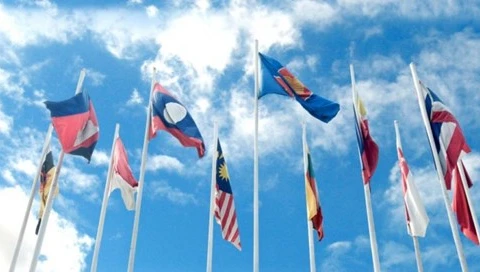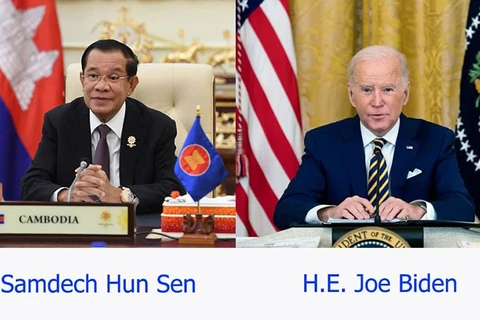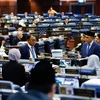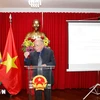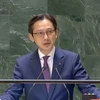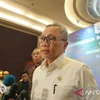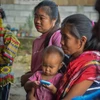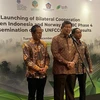Phnom Penh (VNA) - For 2022, three trends should be key for observation on development of Cambodia’s economy, predicted Sim Vireak, a strategic adviser to the Phnom Penh-based Asian Vision Institute (AVI).
The first thing to watch is how well Cambodia can tap the benefits from the success of the inoculation drive, he asserted.
Despite strong efforts to reopen the country and economy, tourists and investors are not yet ready to come back. The strength of the vaccination programme offers assurance that Cambodia’s production capacity and preparedness of working people are intact, Vireak held.
He noted that Cambodia’s global non-gold trade exceeded 36 billion USD in the first 11 months of 2021, rising by more than 24 percent year on year. Goods exports amounted to 15.613 billion USD, up by 22.6 percent, driven by textiles, bicycles, furniture, fur skins, rubber, plastics, wood planks, construction materials, wiring and wiring components, electronic components, sugar, bananas, cassava, mangoes and other agricultural produce.
Imports amounted to 20.4 billion USD, climbing by 25.3 percent, mainly fabrics, construction materials and fuel.
Second, attention should be paid to the quiet but steady progress of public investment and reforms, he stressed.
He explained that this is about turning crisis into opportunities. The pandemic has been turned around as a stimulus for domestic reforms to build more resilience, for robust infrastructure investment, and for formulations of various long-term policies.
On the issue of reform, the long-awaited updated investment law was promulgated on October 15, 2021. The revised law provides better business facilitation and more tailor-made incentives, and encourages investors to focus on priority areas that promote industrial diversification, as well as encouraging provision of support for capacity-building and welfare of workers.
According to Vireak, the third key trend is about the ongoing quest for industrial diversification, which goes hand in hand with market diversification.
It is worth noticing that in recent years the non-garment sector has been on a growth trajectory. The garment sector used to play a leading role in the economy of Cambodia, accounting for 74 percent of total merchandise exports in 2018. Despite the accelerated growth rate of 6.8 percent, garment exports no longer account for the majority of goods exports but rather 45.9 percent of the total, amounting to 5.82 billion USD during the first nine months of 2021.
Exports of travel goods surpassed those of footwear products and became the second-largest item, accounting for 1.04 billion USD. Export of footwear products is third, reaching 1.0 billion USD. The fourth-largest manufacturing export product is bicycles, which amount to 470 million USD.
He noted that as of November, 87.7 percent of the population of about 16 million had been fully vaccinated, and COVID-19 has been under control with fewer than 3,000 deaths.
He cited the MEF prediction that Cambodia’s growth for 2021 at 3.0 percent and 5.6 percent for 2022, expecting the economy gradually to reach its potential in the medium term, supported by global demand and a gradual recovery in investment confidence./.
The first thing to watch is how well Cambodia can tap the benefits from the success of the inoculation drive, he asserted.
Despite strong efforts to reopen the country and economy, tourists and investors are not yet ready to come back. The strength of the vaccination programme offers assurance that Cambodia’s production capacity and preparedness of working people are intact, Vireak held.
He noted that Cambodia’s global non-gold trade exceeded 36 billion USD in the first 11 months of 2021, rising by more than 24 percent year on year. Goods exports amounted to 15.613 billion USD, up by 22.6 percent, driven by textiles, bicycles, furniture, fur skins, rubber, plastics, wood planks, construction materials, wiring and wiring components, electronic components, sugar, bananas, cassava, mangoes and other agricultural produce.
Imports amounted to 20.4 billion USD, climbing by 25.3 percent, mainly fabrics, construction materials and fuel.
Second, attention should be paid to the quiet but steady progress of public investment and reforms, he stressed.
He explained that this is about turning crisis into opportunities. The pandemic has been turned around as a stimulus for domestic reforms to build more resilience, for robust infrastructure investment, and for formulations of various long-term policies.
On the issue of reform, the long-awaited updated investment law was promulgated on October 15, 2021. The revised law provides better business facilitation and more tailor-made incentives, and encourages investors to focus on priority areas that promote industrial diversification, as well as encouraging provision of support for capacity-building and welfare of workers.
According to Vireak, the third key trend is about the ongoing quest for industrial diversification, which goes hand in hand with market diversification.
It is worth noticing that in recent years the non-garment sector has been on a growth trajectory. The garment sector used to play a leading role in the economy of Cambodia, accounting for 74 percent of total merchandise exports in 2018. Despite the accelerated growth rate of 6.8 percent, garment exports no longer account for the majority of goods exports but rather 45.9 percent of the total, amounting to 5.82 billion USD during the first nine months of 2021.
Exports of travel goods surpassed those of footwear products and became the second-largest item, accounting for 1.04 billion USD. Export of footwear products is third, reaching 1.0 billion USD. The fourth-largest manufacturing export product is bicycles, which amount to 470 million USD.
He noted that as of November, 87.7 percent of the population of about 16 million had been fully vaccinated, and COVID-19 has been under control with fewer than 3,000 deaths.
He cited the MEF prediction that Cambodia’s growth for 2021 at 3.0 percent and 5.6 percent for 2022, expecting the economy gradually to reach its potential in the medium term, supported by global demand and a gradual recovery in investment confidence./.
VNA

